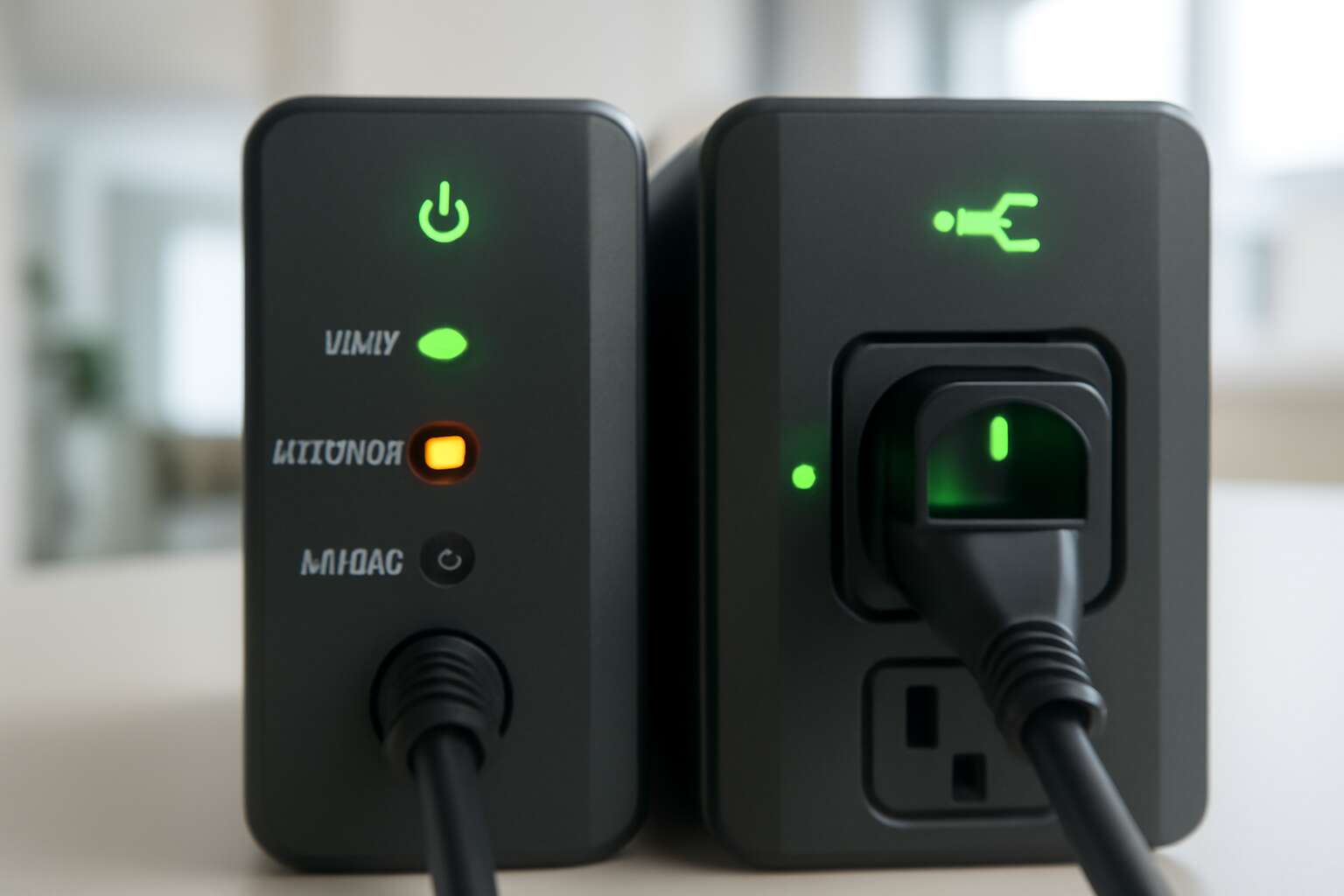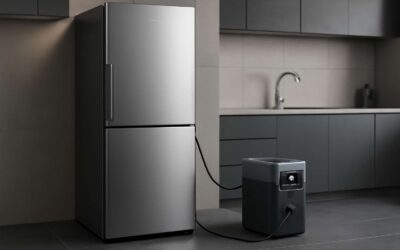Understanding Battery Backup Systems
What is a Battery Backup (UPS)?
Battery backup systems, commonly known as uninterruptible power supplies (UPS), are the silent guardians of our digital lives. They are designed to provide immediate power during outages, safeguarding sensitive electronics from sudden shutdowns. But a question often arises: can you plug a battery backup into a battery backup? This query reveals the curiosity and sometimes confusion surrounding these devices, especially when considering extended power solutions.
Understanding a battery backup system’s core function is crucial. It’s essentially a buffer—an energy reservoir that kicks in when mains power falters. While many assume stacking these systems might be a solution for longer outages, the reality is more complex. Connecting one UPS to another can lead to compatibility issues or even damage. Instead, exploring dedicated solutions like larger capacity units or external batteries might better serve your needs. Remember, the goal is reliability—never compromise safety or efficiency with makeshift setups.
Types of UPS Devices
Understanding the nuances of battery backup systems requires more than surface-level knowledge; it demands an appreciation for their intricate design and purpose. Different types of UPS devices cater to varied needs, from the compact standby models to the more robust online double-conversion units. Each type embodies a distinct approach to power regulation and surge protection, tailored to specific environments and equipment sensitivities.
For those pondering whether you can plug a battery backup into a battery backup, the answer is complex. Generally, these devices are engineered to operate independently, each with its own power management system. Connecting them directly can lead to safety hazards or system failures. Instead, exploring dedicated solutions—like larger capacity UPS units or external battery banks—ensures seamless, reliable power continuity. After all, the goal is to safeguard data and hardware without risking damage through ill-advised configurations.
In essence, while the idea of stacking UPS devices might seem tempting for extended backup durations, it’s rarely the optimal solution. Properly understanding the different types of UPS devices and their intended functions reveals that compatibility issues and inefficiencies often outweigh perceived benefits. When considering a power backup strategy, focus on tailored, manufacturer-recommended solutions rather than makeshift configurations that could compromise safety and performance.
Common Uses and Applications
Battery backup systems are the silent guardians in many South African homes and businesses, ensuring crucial equipment stays powered during blackouts. Their common uses span from protecting data centers and medical facilities to safeguarding home entertainment systems. These devices are designed to provide immediate power support, giving users time to save work or shut down safely amidst unpredictable power surges or outages.
Understanding the practical applications of battery backup systems reveals their vital role in maintaining operational continuity. For example, in remote areas where power instability is frequent, a robust UPS can be the difference between productivity and chaos. However, a frequent question arises: can you plug a battery backup into a battery backup? The answer is layered. Since each UPS is engineered with its own internal management, connecting one directly into another often leads to safety and performance issues. Exploring dedicated solutions like external battery banks or larger capacity UPS units is usually the wiser choice.
Can You Plug a Battery Backup into Another Battery Backup?
Technical Explanation of Connecting Two UPS Units
Imagine a world where your power supply is as resilient as a mythic fortress, standing tall against the chaos of outages. But when it comes to plugging a battery backup into another battery backup, the question often arises: can you plug a battery backup into a battery backup? The answer is more complex than a simple yes or no. Technically, it’s possible, but it’s rarely advisable due to the risks involved. Connecting two UPS units without proper knowledge can lead to electrical imbalances, potential damage to both devices, or even safety hazards.
For those contemplating this setup, it’s crucial to understand the intricacies involved. If you decide to proceed, consider the following:
- Ensure that both units are compatible in terms of voltage and power capacity.
- Use appropriate wiring and connectors designed for such configurations.
- Consult with an electrical specialist to avoid voiding warranties or creating unsafe conditions.
While stacking battery backups may seem like a clever solution to extend runtime, it’s often better to invest in a single, higher-capacity UPS designed for your specific needs. After all, safety and reliability should always be the guiding lights in your power management journey.
Potential Risks and Safety Concerns
At first glance, the idea of stacking power sources might seem like a straightforward way to extend runtime or boost capacity. Yet, beneath this seemingly simple question—can you plug a battery backup into a battery backup?—lies a labyrinth of potential hazards and ethical dilemmas. The allure of creating an unbreakable power fortress can tempt even seasoned professionals, but the reality is far more complex. Electrical imbalances, unexpected surges, and the risk of damaging vital equipment loom large when attempting such connections.
Connecting two UPS units without proper knowledge isn’t just risky—it’s a gamble with safety and reliability. The human tendency to seek quick fixes can blind us to the nuanced dangers involved. For instance, incompatible voltage levels or differing battery chemistries can lead to catastrophic failures. Before attempting to extend your power system, consider the inherent risks and the importance of consulting with electrical specialists who understand the intricacies of power management in high-stakes environments.
In many cases, investing in a single, higher-capacity UPS designed specifically for your needs is a safer and more reliable solution. The desire to push boundaries must be tempered by an awareness that safety and integrity are non-negotiable. After all, when it comes to power backups, the line between innovation and peril can be dangerously thin.
Manufacturer Guidelines and Recommendations
When contemplating the question, “can you plug a battery backup into a battery backup,” the answer is far from straightforward. Manufacturers of UPS devices typically advise against such configurations, emphasizing that each unit is engineered with specific parameters that, if bypassed, can jeopardize both safety and operational integrity. While the allure of extending runtime through stacking might seem tempting, it’s essential to recognize the delicate balance of internal circuitry and battery chemistry involved.
Most reputable manufacturers explicitly recommend against connecting multiple UPS units directly. This guidance isn’t merely bureaucratic red tape but a reflection of the complex electrical dynamics at play. For instance, attempting to combine two units without adhering to precise specifications can lead to voltage imbalances or unexpected surges. These risks underscore the importance of adhering strictly to manufacturer guidelines and consulting with qualified electrical specialists before considering any such modifications.
In many cases, the safest and most effective solution is to invest in a single, higher-capacity UPS tailored to your specific power requirements. If you’re still pondering whether you can plug a battery backup into a battery backup, remember that the intricacies of power management demand respect, not experimentation. When safety and reliability are paramount, following manufacturer recommendations isn’t just prudent—it’s essential.
Alternatives to Plugging UPS Units Together
Implementing Extended Backup Power Solutions
In the labyrinth of modern power management, where every second of uptime can mean the difference between chaos and control, the question arises—can you plug a battery backup into a battery backup? The answer is not a simple yes or no, but a nuanced exploration of safety, efficiency, and purpose. While the idea of stacking UPS units might seem alluring to extend backup power, it’s akin to stacking fragile glass—tempting yet perilous if not done with meticulous care and expert guidance.
Instead of risking damage or voiding warranties, many opt for more sophisticated alternatives. Implementing extended backup power solutions can involve selecting a single, high-capacity UPS system designed for your specific needs or integrating an uninterruptible power supply with an auxiliary generator. These approaches promise seamless power flow without the peril of unintended consequences.
- Using a single, larger UPS unit tailored for extended runtime
- Incorporating a dedicated generator for prolonged outages
- Employing power distribution units that optimize load balancing and backup duration
Embracing these alternatives ensures resilience in the face of South Africa’s unpredictable power grid, safeguarding your vital equipment without risking the hazards of daisy-chaining UPS units. After all, true power preservation is an art—one that demands respect for the delicate dance between safety and function.
Using External Batteries with a Single UPS
When it comes to extending backup power, many wonder, can you plug a battery backup into a battery backup? The answer is complex, often leaning toward caution. Instead of stacking UPS units, which risks safety and efficiency, consider more reliable alternatives that ensure your vital equipment stays powered during unexpected outages.
One effective method is to opt for a single, high-capacity UPS that is specifically designed for extended runtime. These units are engineered to handle larger loads safely, providing peace of mind without the hazards associated with daisy-chaining. Additionally, integrating a dedicated generator can offer long-term backup power—ideal for areas with frequent or prolonged outages.
For optimized load management, employing power distribution units (PDUs) can help balance the electrical load across your backup infrastructure. This approach not only safeguards your equipment but also maximizes backup duration, ensuring operational stability in uncertain times.
Power Management Best Practices
In the realm of uninterruptible power supplies, the question often arises: can you plug a battery backup into a battery backup? While the idea might seem tempting to extend backup power, it’s a delicate dance of safety and efficiency. Stacking UPS units, for example, is fraught with potential hazards that can compromise your equipment and void warranties. Instead, exploring smarter alternatives can offer peace of mind and operational stability.
One prudent approach involves investing in a single, high-capacity UPS designed for extended runtime. These units are meticulously engineered to handle larger loads without risking overload or damage. For those seeking even greater resilience, integrating a dedicated generator provides a long-term power solution—perfect for areas prone to frequent outages. To optimize load management, employing power distribution units (PDUs) can distribute electrical demand evenly, preventing overloads and ensuring your critical devices stay powered when it matters most.
How to Maximize Battery Backup Efficiency
Proper Maintenance and Battery Care
In the shadowed corridors of power, where darkness often looms just beyond the flickering glow of technology, understanding the intricacies of battery backup systems becomes a vital craft. When contemplating whether you can plug a battery backup into a battery backup, one must tread with caution—an act that whispers promises of extended resilience but harbors potential peril if done without heed. The question isn’t merely about connection; it’s about the delicate dance of energy, safety, and efficiency that defines modern power management.
Maximizing the efficiency of your battery backup demands meticulous maintenance and vigilant battery care. The heart of the system, the batteries, must be kept in optimal condition—clean, dry, and free from corrosion. Regularly testing the backup’s capacity helps reveal hidden vulnerabilities, ensuring it awakens when darkness truly falls. Consider implementing a routine check of voltage levels and inspecting for any signs of wear or swelling. This ritual of care preserves the silent guardians that shield your vital systems from the abyss of power loss.
Sometimes, the allure of boosting backup duration leads to stacking units—yet, the question remains: can you plug a battery backup into a battery backup? The answer is shrouded in caution. While some advanced configurations may allow daisy chaining, it’s imperative to heed manufacturer guidelines. Improper connection risks creating a cascade of failures, akin to summoning shadows that cannot be contained. Instead, focus on proper maintenance and understanding the limits of your system, ensuring it stands resilient against the encroaching night.
Load Management Strategies
In the labyrinth of power resilience, efficiency hinges on understanding the subtle nuances of load management strategies. When pondering whether you can plug a battery backup into a battery backup, the temptation to extend uptime can be alluring, yet it demands a nuanced approach. Optimal performance arises not merely from stacking units but from orchestrating their energy flow with precision.
Maximizing battery backup efficiency involves balancing load demands meticulously. Overloading the system can cause premature wear or failure, undermining the very resilience you seek. Instead, consider implementing a layered approach—distributing critical devices across multiple backup units to prevent overtaxing a single source.
- Prioritize essential systems to ensure uninterrupted operation.
- Monitor real-time voltage and current levels diligently.
- Schedule routine testing to identify potential bottlenecks before they manifest.
Understanding the limits of your power infrastructure and respecting manufacturer recommendations enhances the longevity of your system. While the question remains: can you plug a battery backup into a battery backup, the true answer lies in strategic load management and safeguarding your power sanctuary against the chaos of unexpected outages.
Upgrading Your UPS System
In the shadowed corridors of power resilience, one question echoes with a haunting clarity: can you plug a battery backup into a battery backup? As the darkness of an outage looms, the temptation to extend your sanctuary’s life grows stronger. Yet, beneath this allure lies a labyrinth of technical intricacies. To truly maximize battery backup efficiency, it is essential to understand that stacking units without strategic foresight risks awakening the wrath of system failure.
The key to a resilient, enduring power fortress is meticulous load balancing. Consider implementing a layered approach—distributing your critical devices across multiple backup units—curbing the peril of overtaxing a single source. This careful orchestration ensures your power remains unbroken, even when chaos strikes. When upgrading your UPS system, focus on integrating external batteries thoughtfully, respecting manufacturer guidelines and the delicate dance of energy flow.
In the darkness, every watt counts. Vigilant monitoring of voltage and current levels, paired with routine testing, can reveal bottlenecks before they manifest as catastrophic failures. While the question remains—can you plug a battery backup into a battery backup?—the true answer hinges on your mastery of load management and the silent art of safeguarding your power sanctuary against the shadows of unexpected outages.
Frequently Asked Questions About Battery Backups
Can You Chain Multiple UPS Units?
Many underestimate the allure of extending uninterrupted power, but can you plug a battery backup into a battery backup without risking chaos? It’s a question that stirs curiosity among tech enthusiasts and professionals alike. The simple answer is that while it might seem tempting to double your backup capacity, doing so isn’t as straightforward as plugging one unit into another. In fact, most manufacturers advise against chaining multiple UPS devices because it can lead to unpredictable behavior, overloads, or even damage to the units.
However, there are specific scenarios and configurations where connecting multiple UPS units is possible, but these usually require specialized equipment or external batteries designed for such setups. For the average user, the safest route remains adhering to manufacturer guidelines. If you’re wondering, ‘can you plug a battery backup into a battery backup,’ the key is understanding the limitations and the potential dangers of such configurations. Sometimes, safety and reliability outweigh the allure of extra backup time.
What Happens if You Overload a UPS?
When the shadows lengthen and darkness cloaks the world, the last thing you want is your vital systems succumbing to the flicker of power failure. Yet, many wonder, can you plug a battery backup into a battery backup? The truth is, overloading a UPS isn’t just a matter of inconvenience; it’s a descent into chaos. If you push beyond the unit’s capacity, you risk triggering a cascade of failures—fuses blow, circuits trip, and in worst cases, damage becomes irreversible.
What happens if you overload a UPS? The device might shut down suddenly, leaving your electronics vulnerable—an ominous silence in the night. Sometimes, the overload causes the internal components to overheat, reducing the lifespan of the battery backup and risking a dangerous fire hazard. It’s a dark, silent warning that pushing the limits of your power protection isn’t worth the peril. To avoid such dangers, it’s essential to respect the power ratings and never attempt to extend backup capacity by chaining units in a way that the manufacturer’s warnings clearly advise against.
How to Safely Extend UPS Runtime
In the labyrinth of power protection, questions echo like distant thunder—resonant and urgent. One such query, often whispered in the shadows of technical discussions, is: can you plug a battery backup into a battery backup? The allure of extending your uninterruptible power supply (UPS) runtime tempts even the most cautious, yet the answer is layered with caution and consequence. When two units are chained without due diligence, the harmony of electrical flow can morph into a cacophony of failures. The delicate circuitry within each UPS is designed with specific limits, and overstepping these boundaries risks more than just a system shutdown—it endangers your entire setup.
Many wonder if stacking UPS units is a viable strategy to prolong backup power. While it might seem a straightforward solution, it’s akin to stacking fragile glass—beautiful but perilous. The safest approach involves understanding the technical intricacies and manufacturer guidelines. Remember, when you ask, can you plug a battery backup into a battery backup, the answer hinges on context and caution. If done heedlessly, it can lead to catastrophic failure, draining your confidence in the very system meant to safeguard your vital devices.



0 Comments